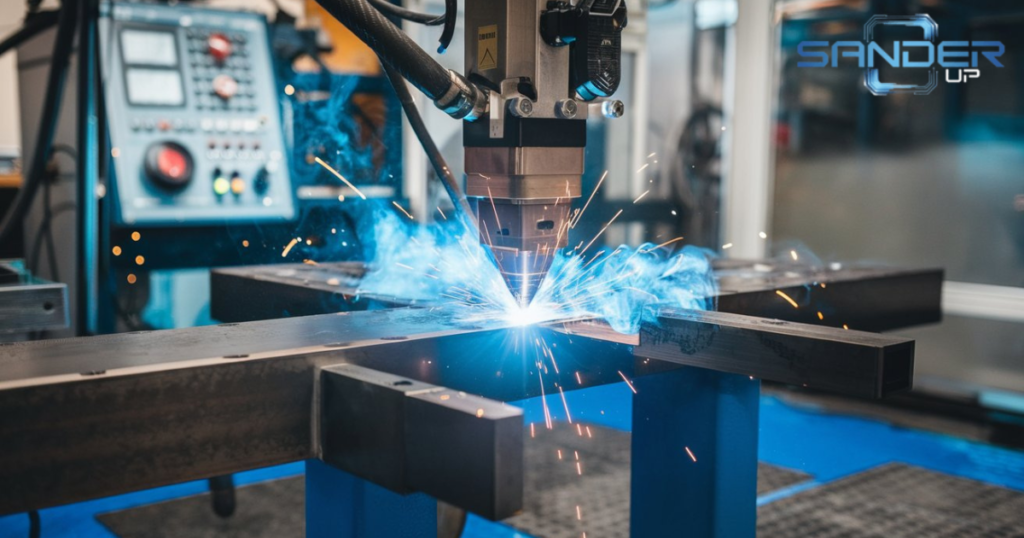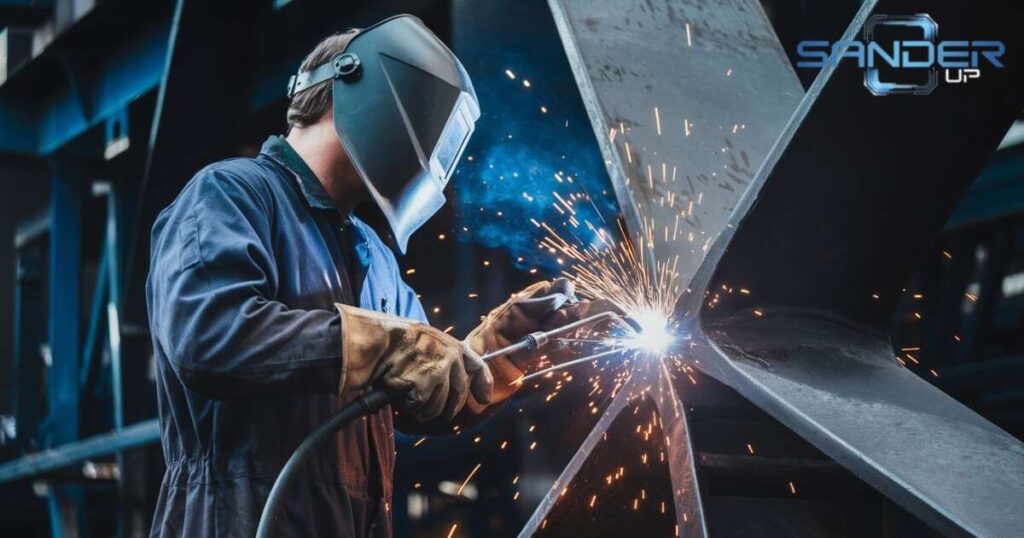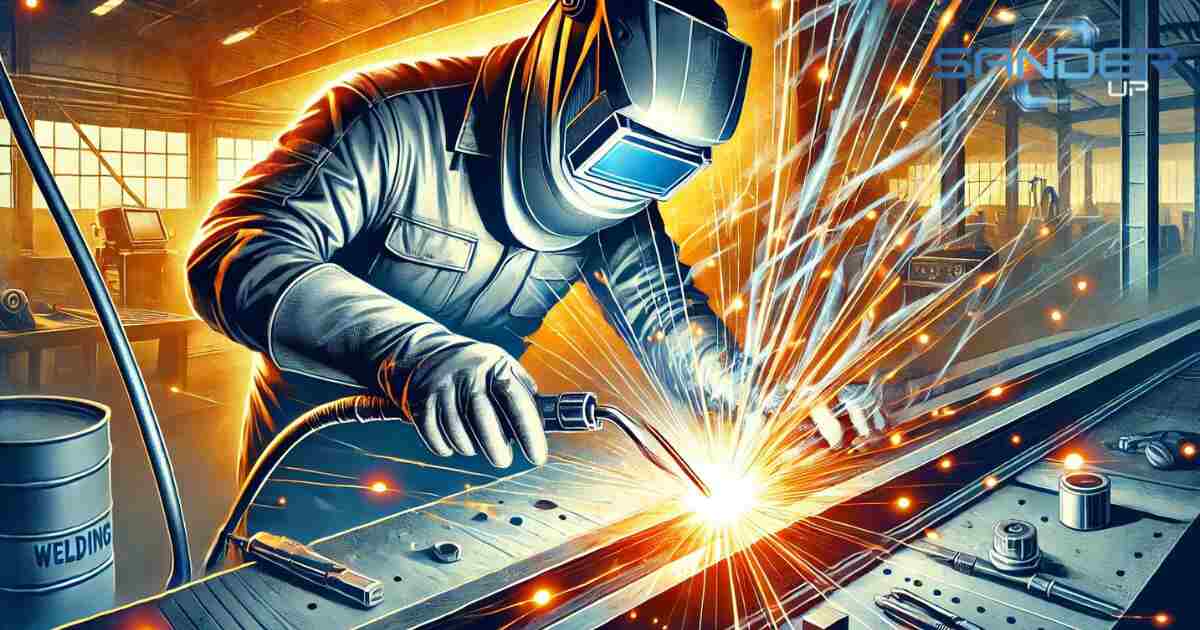Welding is a process that joins two materials, usually metals or thermoplastics, by applying heat, pressure, or both. The materials melt and fuse together to form a strong bond. This method is commonly used in construction, manufacturing, and repairs.
There are different types of welding processes, such as MIG, TIG, and arc welding. Each process uses different techniques and tools. Welds can also vary, like butt joints, lap joints, and corner joints. The right process and weld type depend on the materials and the job requirements.
What is Welding?
Welding is a fabrication process that joins materials together by melting them at their contact points. It often involves metals or thermoplastics. The goal is to create a strong bond between the pieces.
In welding, heat is applied to melt the materials. This can be done using various methods. Common techniques include arc welding, MIG welding, and TIG welding.
Welding is widely used in construction, manufacturing, and repair work. It is essential for building structures like bridges and ships.
Safety is crucial during welding. Welders must wear protective gear to shield themselves from sparks and harmful fumes. Proper training is also necessary to ensure safe practices.
How Does Welding Work?
Welding is a process that joins materials, typically metals, through heat and pressure. This technique is widely used in various industries.
Joining Metals
In metal welding, heat is applied to melt the edges of the metals being joined. Once melted, the materials fuse together as they cool. Different methods, such as arc welding and MIG welding, are used depending on the materials and desired strength. Welding can create strong and durable joints.
Joining Plastics
Plastic welding involves using heat to soften the edges of plastic parts. This process can be done with hot air or specialized tools. As the edges soften, they are pressed together to form a bond. This method is popular in manufacturing and repairs. It produces strong and flexible joints.
Joining Wood
Wood welding, or wood bonding, uses adhesives or heat to join wooden pieces. In some cases, heat is applied to soften the wood fibers, allowing them to bond better. This method is common in furniture making and construction. It creates strong joints that enhance the durability of wooden structures.
Common Joint Configurations
Joint configurations are crucial in welding, as they determine the strength and stability of the welded connection. Different configurations are used for various applications and materials.
Butt Joint
A butt joint is formed when two pieces of material are placed end to end. This configuration is simple and effective for joining metals and plastics. It provides a strong connection, making it a popular choice in construction and fabrication.
Corner Joint
A corner joint connects two pieces of material at a right angle. This configuration is often used in frames and structures. It can be welded on the inside or outside, depending on the design and required strength.
T-Joint
A T-joint is created when one piece of material is placed perpendicular to another. This configuration resembles the letter “T.” It is commonly used in constructing frames and supports. Proper welding techniques ensure a strong bond.
Lap Joint
A lap joint overlaps two pieces of material. This configuration is widely used in sheet metal work and assembly. It allows for a larger surface area for welding, resulting in a strong joint.
Edge Joint
An edge joint connects the edges of two pieces of material. This configuration is often used in thin materials where a butt joint is not feasible. It is less common but effective for specific applications, especially in sheet metal fabrication.
Types of Welding Joints
Welding joints come in various types based on how the materials are connected. Understanding these helps in selecting the right technique for the job.
Welds Based on Configuration
These joints are categorized by the shape and alignment of the materials. Common types include butt joints, where two pieces are placed edge to edge, and lap joints, where one piece overlaps another. Other types like corner, edge, and T-joints also fall under this category.
Based on Penetration
Penetration refers to how deep the weld fuses into the material. Full penetration welds go through the entire thickness of the material, creating a very strong bond. Partial penetration welds, on the other hand, only fuse the surfaces, suitable for less critical joints.
Welds Based on Accessibility
These joints depend on how easy it is to access the welding area. Some welds, like groove or fillet welds, are applied to areas that are easy to reach. Other times, the location may require special tools or techniques for hard-to-reach spaces, affecting the joint type.
Features of Completed Welds
A completed weld is judged by its appearance and strength. Key features include the weld size, shape, and smoothness. A good weld will have consistent quality without cracks or gaps. These features determine the durability and functionality of the joint.
What Are the Different Types of Welding and What Are They Used For?

Welding is a crucial process in many industries, and various techniques are designed to meet specific needs. Here’s a detailed look at the different types of welding and their applications.
Arc Welding
Arc welding is a versatile method that uses an electric arc to create heat. This heat melts the workpieces and allows them to fuse. It is widely used in construction, manufacturing, and repair work. Arc welding is effective for thick materials and is common in steel fabrication, pipelines, and heavy equipment repairs.
Different types of arc welding include Shielded Metal Arc Welding (SMAW) and Gas Metal Arc Welding (GMAW). SMAW, commonly known as stick welding, uses a consumable electrode coated in flux.
It is popular in construction and shipbuilding due to its simplicity and effectiveness in outdoor conditions. GMAW, also known as MIG (Metal Inert Gas) welding, feeds a continuous wire electrode into the weld pool. This method is often used in automotive and fabrication industries because it allows for quick, clean welds.
MIG Welding
MIG welding is a popular process that combines a continuously fed wire electrode with an inert gas shield to protect the weld from contamination. This method is ideal for welding thin materials and is often used in automotive assembly and light fabrication. Its speed and ease of use make it suitable for production environments.
TIG Welding
TIG welding uses a non-consumable tungsten electrode to produce the weld. The welder manually feeds filler material into the weld pool. This method is favored for its precision and control, making it suitable for welding thin sections of stainless steel, aluminum, and other non-ferrous materials. It is commonly used in aerospace, art, and high-end fabrication.
Stick Welding
Stick welding, or SMAW, is one of the oldest welding methods. It uses a coated electrode to create an electric arc between the electrode and the workpiece. This technique is widely used in outdoor and heavy construction projects due to its simplicity and ability to work in various conditions. It is suitable for welding steel and iron, particularly in maintenance and repair applications.
Flux-Cored Arc Welding (FCAW)
FCAW is similar to MIG welding but uses a hollow electrode filled with flux. This allows for self-shielding, meaning it doesn’t require a separate gas supply. FCAW is effective for welding thick materials and is often used in construction, shipbuilding, and structural applications. It performs well in outdoor conditions and can be used on a variety of metals.
Submerged Arc Welding (SAW)
SAW involves creating an arc between the workpiece and a continuously fed electrode beneath a blanket of granular flux. This method produces deep penetration and is highly efficient for welding thick sections of steel.
It is commonly used in large-scale industrial applications such as pipe and tank fabrication, where high-quality welds are required.
Resistance Welding
Resistance welding uses the heat generated by electrical resistance to join materials. This method is mainly used for spot welding in the automotive industry. It is effective for thin sheets of metal and provides quick, consistent results, making it ideal for mass production.
Laser Welding

Laser welding uses a concentrated beam of light to melt materials. The precision of this method allows for intricate welds with minimal heat input. Laser welding is often used in industries that require high accuracy, such as electronics, medical device manufacturing, and aerospace. It is suitable for welding thin materials and can produce clean, strong joints.
Electron Beam Welding
Electron beam welding employs a beam of high-energy electrons to create a weld in a vacuum environment. This method is ideal for joining thick materials and complex shapes. It is primarily used in the aerospace and nuclear industries, where high strength and integrity are essential. Electron beam welding produces very little heat-affected zone, minimizing distortion.
Welding Process

Welding is a complex procedure that involves several key steps to ensure the successful joining of materials. Understanding this process helps in achieving strong and durable welds.
Preparation
The first step in the welding process is preparation. This involves cleaning the surfaces of the materials to be joined. Removing contaminants like dirt, rust, and oil is crucial for a strong bond. Proper alignment of the workpieces is also necessary to ensure accurate welding.
Fitting and Clamping
Once the surfaces are clean, the next step is fitting and clamping the materials together. This ensures they are held securely in place during the welding process. Accurate alignment is important to avoid misalignment during welding. Clamps and fixtures are often used to maintain stability.
Heating
Heating is a critical phase in welding. Depending on the welding method, heat is applied through various means, such as electric arcs, flames, or lasers.
This heat melts the edges of the materials, allowing them to fuse together. The amount of heat and duration depends on the materials being welded and the specific technique used.
Filling
In some welding methods, a filler material is added to the weld pool. This filler helps strengthen the joint and fill any gaps between the materials. The choice of filler material is important, as it should match the base metals for compatibility.
Cooling
After the materials are melted and fused, they need to cool down. Cooling can occur naturally or be accelerated using fans or other methods. Controlled cooling is important to prevent warping and ensure the integrity of the weld.
Inspection
Once the weld has cooled, it is essential to inspect the joint for quality. This can involve visual checks, as well as non-destructive testing methods such as ultrasonic or radiographic inspection. Identifying defects early helps ensure the strength and reliability of the weld.
Finishing
The final step in the welding process is finishing. This may involve grinding, polishing, or applying protective coatings to improve the appearance and corrosion resistance of the weld. Proper finishing enhances the overall quality and longevity of the welded joint.
By following these steps in the welding process, welders can produce strong, durable joints that meet the specific requirements of various applications. Understanding each phase is vital for achieving high-quality welds in any project.
Welding Safety
Welding is essential in many industries. However, it can be dangerous without proper safety measures. Understanding welding safety is crucial for everyone involved.
First, always wear appropriate protective gear. This includes a welding helmet, gloves, and protective clothing. These items shield you from sparks, heat, and harmful radiation.
Ensure proper ventilation in your workspace. Fumes produced during welding can be hazardous. Use exhaust fans or work outside when possible to reduce exposure.
Be aware of your surroundings. Keep flammable materials away from the welding area. Clear the space of any debris or hazards to prevent accidents.
Use tools and equipment correctly. Inspect your welding equipment regularly. Make sure everything is in good condition to avoid malfunctions.
Finally, stay informed about safety practices. Attend safety training sessions. Keeping up-to-date with safety guidelines helps prevent injuries and accidents in the workplace.
How to Become a Welder
Becoming a welder involves several steps. First, you need to understand the basics of welding. Research different welding processes, such as MIG, TIG, and stick welding. Each has unique techniques and applications.
Next, consider enrolling in a welding program. Many community colleges and vocational schools offer courses. These programs provide hands-on training and knowledge about safety practices. Learning from experienced instructors is invaluable.
After completing your education, gaining practical experience is essential. Look for internships or apprenticeships. These opportunities allow you to work under skilled welders and learn the trade.
Obtaining certifications can enhance your job prospects. Certifications prove your skills to employers. Organizations like the American Welding Society (AWS) offer various certifications based on welding types.
Finally, keep improving your skills. Welding technology evolves, and ongoing education can help you stay current. Join professional organizations to network and learn from others in the field. With dedication and practice, you can build a successful welding career.
Frequently Asked Questions
What is MIG/MAG?
MIG (Metal Inert Gas) and MAG (Metal Active Gas) are welding processes that use a continuous wire electrode to join metals.
In MIG welding, an inert gas like argon protects the weld from contamination. In MAG welding, an active gas like carbon dioxide is used, which can improve penetration but may affect the weld’s quality. Both methods are popular for their speed and versatility in welding various materials.
What is Submerged-arc Welding?
Submerged-arc welding (SAW) is a welding process that uses a continuously fed wire electrode. The arc is submerged under a layer of granular flux, which protects the weld pool from contamination and helps control heat.
This process produces deep weld penetration and is often used for thick materials in applications like shipbuilding and construction. It is known for its high productivity and quality.
What is Fusion Welding?
Fusion welding is a process that joins materials by melting them together. It typically involves applying heat to the base metals until they reach their melting point, allowing them to fuse into a single piece as they cool.
This method can be used for various materials, including metals and thermoplastics. Common fusion welding techniques include arc welding, gas welding, and laser welding. It’s known for creating strong, durable joints.
What is Spot Welding?
Spot welding is a type of resistance welding used to join two or more metal sheets at specific points, or “spots.”
In this process, two electrodes apply pressure and pass an electric current through the sheets, generating heat at the contact points. This heat melts the metal, forming a weld nugget as it cools. Spot welding is commonly used in the automotive industry for assembling car bodies and other structures due to its speed and efficiency.
Welding is used to join materials, mainly metals, to create strong and permanent connections. Here are some key reasons:
Why do we weld?
1. Strength: Welded joints are typically stronger than the base materials.
2. Versatility: It can be used on various materials and in different industries, including construction, manufacturing, and automotive.
3. Cost-Effective: Welding can reduce the need for fasteners and other joining methods, lowering production costs.
4. Design Flexibility: It allows for complex shapes and designs in structures and products.
5. Repair: Welding can fix damaged parts, extending their lifespan and reducing waste.
How much does a welder make an hour?
The hourly wage for a welder varies by location, experience, and type of welding. On average, welders in the U.S. make between $17 and $30 per hour.
Entry-level positions may start around $15 an hour, while experienced welders, especially those with specialized skills, can earn $35 or more. In some regions or industries, skilled welders can make even higher wages.
What welding jobs pay over 100k per year?
Several welding jobs can pay over $100,000 per year, especially with experience and specialized skills. Here are some examples:
1. Certified Welding Inspector (CWI): Inspectors ensure welding quality and compliance with standards, often earning high salaries.
2. Underwater Welder: Working underwater, these welders can command high wages due to the risks involved.
3. Pipeline Welder: Specialized welders working on oil and gas pipelines often earn substantial salaries due to the nature of the work.
4. Welding Engineer: Engineers design and oversee welding processes and often earn six-figure salaries.
5. Welding Supervisor/Manager: Those in leadership positions in welding operations can also earn over $100,000, depending on the company and location.
Which gas is used in welding?
Common gases used in welding include argon and carbon dioxide for shielding. Acetylene is used in oxy-acetylene welding for cutting and joining metals.
Where can you learn to weld?
You can learn welding at trade schools, community colleges, or through apprenticeship programs. Some companies also offer on-the-job training for welding skills.
What are the 4 types of welding?
he four main types of welding are:
- MIG (Metal Inert Gas) Welding
- TIG (Tungsten Inert Gas) Welding
- Stick Welding (Shielded Metal Arc Welding)
- Flux-Cored Arc Welding (FCAW)











